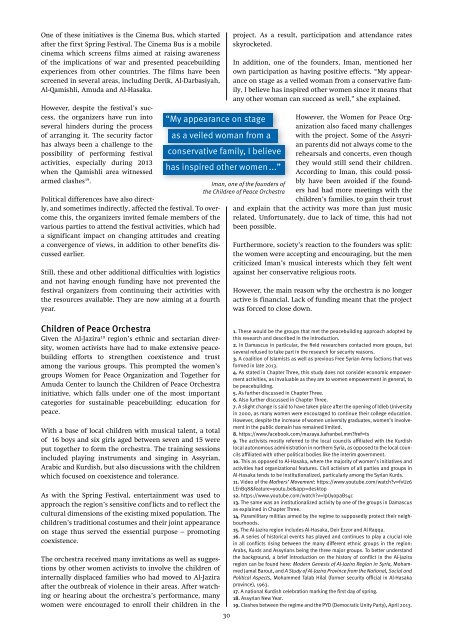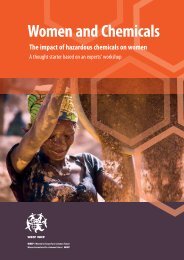future now”
YAO19
YAO19
You also want an ePaper? Increase the reach of your titles
YUMPU automatically turns print PDFs into web optimized ePapers that Google loves.
One of these initiatives is the Cinema Bus, which started<br />
after the first Spring Festival. The Cinema Bus is a mobile<br />
cinema which screens films aimed at raising awareness<br />
of the implications of war and presented peacebuilding<br />
experiences from other countries. The films have been<br />
screened in several areas, including Derik, Al-Darbasiyah,<br />
Al-Qamishli, Amuda and Al-Hasaka.<br />
However, despite the festival’s success,<br />
the organizers have run into<br />
several hinders during the process<br />
of arranging it. The security factor<br />
has always been a challenge to the<br />
possibility of performing festival<br />
activities, especially during 2013<br />
when the Qamishli area witnessed<br />
armed clashes 19 .<br />
“My appearance on stage<br />
as a veiled woman from a<br />
Political differences have also directly,<br />
and sometimes indirectly, affected the festival. To overcome<br />
this, the organizers invited female members of the<br />
various parties to attend the festival activities, which had<br />
a significant impact on changing attitudes and creating<br />
a convergence of views, in addition to other benefits discussed<br />
earlier.<br />
Still, these and other additional difficulties with logistics<br />
and not having enough funding have not prevented the<br />
festival organizers from continuing their activities with<br />
the resources available. They are now aiming at a fourth<br />
year.<br />
Children of Peace Orchestra<br />
Given the Al-Jazira 19 region’s ethnic and sectarian diversity,<br />
women activists have had to make extensive peacebuilding<br />
efforts to strengthen coexistence and trust<br />
among the various groups. This prompted the women’s<br />
groups Women for Peace Organization and Together for<br />
Amuda Center to launch the Children of Peace Orchestra<br />
initiative, which falls under one of the most important<br />
categories for sustainable peacebuilding: education for<br />
peace.<br />
With a base of local children with musical talent, a total<br />
of 16 boys and six girls aged between seven and 15 were<br />
put together to form the orchestra. The training sessions<br />
included playing instruments and singing in Assyrian,<br />
Arabic and Kurdish, but also discussions with the children<br />
which focused on coexistence and tolerance.<br />
As with the Spring Festival, entertainment was used to<br />
approach the region’s sensitive conflicts and to reflect the<br />
cultural dimensions of the existing mixed population. The<br />
children’s traditional costumes and their joint appearance<br />
on stage thus served the essential purpose – promoting<br />
coexistence.<br />
The orchestra received many invitations as well as suggestions<br />
by other women activists to involve the children of<br />
internally displaced families who had moved to Al-Jazira<br />
after the outbreak of violence in their areas. After watching<br />
or hearing about the orchestra’s performance, many<br />
women were encouraged to enroll their children in the<br />
conservative family, I believe<br />
has inspired other women ...”<br />
30<br />
project. As a result, participation and attendance rates<br />
skyrocketed.<br />
In addition, one of the founders, Iman, mentioned her<br />
own participation as having positive effects. “My appearance<br />
on stage as a veiled woman from a conservative family,<br />
I believe has inspired other women since it means that<br />
any other woman can succeed as well,” she explained.<br />
However, the Women for Peace Organization<br />
also faced many challenges<br />
with the project. Some of the Assyrian<br />
parents did not always come to the<br />
rehearsals and concerts, even though<br />
they would still send their children.<br />
According to Iman, this could possibly<br />
have been avoided if the founders<br />
had had more meetings with the<br />
children’s families, to gain their trust<br />
and explain that the activity was more than just music<br />
related. Unfortunately, due to lack of time, this had not<br />
been possible.<br />
Iman, one of the founders of<br />
the Children of Peace Orchestra<br />
Furthermore, society’s reaction to the founders was split:<br />
the women were accepting and encouraging, but the men<br />
criticized Iman’s musical interests which they felt went<br />
against her conservative religious roots.<br />
However, the main reason why the orchestra is no longer<br />
active is financial. Lack of funding meant that the project<br />
was forced to close down.<br />
1. These would be the groups that met the peacebuilding approach adopted by<br />
this research and described in the Introduction.<br />
2. In Damascus in particular, the field researchers contacted more groups, but<br />
several refused to take part in the research for security reasons.<br />
3. A coalition of Islamists as well as previous Free Syrian Army factions that was<br />
formed in late 2013.<br />
4. As stated in Chapter Three, this study does not consider economic empowerment<br />
activities, as invaluable as they are to women empowerment in general, to<br />
be peacebuilding.<br />
5. As further discussed in Chapter Three.<br />
6. Also further discussed in Chapter Three.<br />
7. A slight change is said to have taken place after the opening of Idleb University<br />
in 2000, as many women were encouraged to continue their college education.<br />
However, despite the increase of women university graduates, women’s involvement<br />
in the public domain has remained limited.<br />
8. https://www.facebook.com/mazaya.kafranbel.mm?fref=ts<br />
9. The activists mostly referred to the local councils affiliated with the Kurdish<br />
local autonomous administration in northern Syria, as opposed to the local councils<br />
affiliated with other political bodies like the interim government.<br />
10. This as opposed to Al-Hasaka, where the majority of women’s initiatives and<br />
activities had organizational features. Civil activism of all parties and groups in<br />
Al-Hasaka tends to be institutionalized, particularly among the Syrian Kurds.<br />
11. Video of the Mothers’ Movement: https://www.youtube.com/watch?v=fvUz6<br />
LEnBq8&feature=youtu.be&app=desktop<br />
12. https://www.youtube.com/watch?v=IpUyopaBs4c<br />
13. The same was an institutionalized activity by one of the groups in Damascus<br />
as explained in Chapter Three.<br />
14. Paramilitary militias armed by the regime to supposedly protect their neighbourhoods.<br />
15. The Al-Jazira region includes Al-Hasaka, Deir Ezzor and Al Raqqa.<br />
16. A series of historical events has played and continues to play a crucial role<br />
in all conflicts rising between the many different ethnic groups in the region:<br />
Arabs, Kurds and Assyrians being the three major groups. To better understand<br />
the background, a brief introduction on the history of conflict in the Al-Jazira<br />
region can be found here: Modern Genesis of Al-Jazira Region in Syria, Mohammed<br />
Jamal Barout, and A Study of Al-Jazira Province from the National, Social and<br />
Political Aspects, Mohammed Talab Hilal (former security official in Al-Hasaka<br />
province), 1963.<br />
17. A national Kurdish celebration marking the first day of spring.<br />
18. Assyrian New Year.<br />
19. Clashes between the regime and the PYD (Democratic Unity Party), April 2013.



